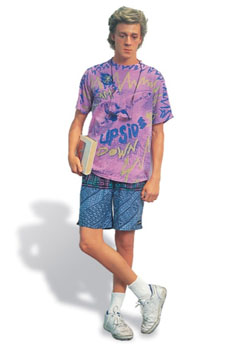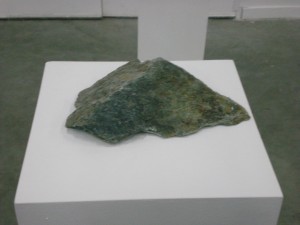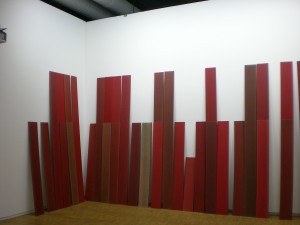
Duane Hanson, "High School Student," 1990. Bronze, polychromed with oil, mixed media accessories, 70 1/2 x 24 1/2 x 17 inches. Courtesy Emmanuel Perotin Gallery, Paris.
(Disclaimer: this Letter from London is actually from Paris.)
Paris’s gallery zone, clustered for the most part around the Marais district east of the center, is so amazingly lovely and elegant that even the most vituperative conceptual art looks like a pithy witticism at a nineteenth-century dinner party met with high, tinkling nineteenth-century laughter. In the right light, it makes London’s galleries look snarky and scruffy. As Adam Ant so aptly put it, “Young Parisians are so French/not like me and you.”
![dscn4058 Stephane Vigny at Galerie LHK [photo: BS]](https://magazine.art21.org/wp-content/uploads/2009/06/dscn4058-300x225.jpg)
Stephane Vigny at Galerie LHK. Photo: Ben Street.
Stephane Vigny, showing at Galerie LHK (as curated by Daria de Beauvais) shows an array of apparently unaltered building materials: a great concrete cylinder supported by museum-style brackets, corrugated plastic tubing sprouting from the floor, aluminum guttering snaking below the cornice. Vigny’s frank aesthetic is leavened by a lightly held, mordant wit. A door-sized sheet of glass leans against the wall, complete with obsolete peephole; masticated chewing gum lines the inside of the gallery window, like putty; a pencil sharpener is set into the wall at the artist’s groin height, called, inevitably, Glory Hole (yowch). While Vigny’s trenchant references to minimalism’s stony-faced employment of unadulterated industrial materials is sort of funny, if a bit passé (I mean, hasn’t minimalism been parodied enough?), where it succeeds is in his eccentric enjoyment of the doggedly ugly. The dominant sculpture—a prehistoric dolmen in concrete, made to appear like polystyrene—is slapstick archaeology, dumb as a brick, and perhaps unintentionally reminiscent of Spinal Tap’s “Stonehenge.” It’s the visual equivalent of Nigel Tufnel’s explanation of the druids: “Nobody knows ‘oo they were…or what they were doin.'” Vigny’s work starts as a challenge and ends as a charm. It’s an old gag, but it still works.

Luca Francesconi at the Palais de Tokyo
Vigny’s concrete electricity pylons also feature in the new group show across town at the Palais de Tokyo. Laid as a pair in the entrance to the show Spy Numbers, they’re easy to miss around the artfully exposed concrete and laissez-faire industrial chic of the Palais (in fact, you sometimes have to double check that you’re seeing an interior design feature and not a Vigny). The Palais de Tokyo can veer towards curatorial contrivance, but Spy Numbers, which occupies a vast, split-level hall of the ground floor, holds together well, never forcing a relationship between works for the sake of a thesis. As a chronically myopic guy, I was drawn to Norma Jeane’s twin petri dishes, each containing 365 one-day contact lenses—a year’s worth of looking, crammed in like frogs’ spawn. Luca Francesconi’s To Lower the Mountains—four vaguely pyramidal chunks of rock displayed on pedestals—is actually the peaks of four Alpine mountains, lopped off by the artist on a hike and transported back down again, in a supremely quixotic act reminiscent of Hans Schabus. Willfully fruitless romanticism is ubiquitous in contemporary art, but Francesconi’s work manages to retain a clear-eyed lack of sentimentality that’s pretty rare in that particular sub-genre. Other works—cylinders playing recordings of the building’s electromagnetic activity, a complex apparatus designed to create an aurora borealis—make reference to the exhibition’s vaunted interest in mysterious radio signals and clandestine messaging systems, but that’s all for the birds. Spy Numbers brings a welcome blast of whimsy to an overserious institution.

"La Force de l'Art" at the Grand Palais
Unfortunately, that can’t be said for the triennial of French art at the Grand Palais, the unhappily named La Force de L’Art. The Grand Palais, a cathedral of green steel and glass, built for the 1900 Exposition Universelle, recently housed Richard Serra’s huge rectangular steel slabs which, on photographic evidence, enjoyed a symbiotic relationship with the architecture not achieved in the current installation. A white-painted plywood platform, with exhibition spaces branching off it, has quickly attained a taxonomy of shoemarks, like dinosaur footprints held in clay; the clank and stomp of shoes is a permanent off-kilter backbeat. The soaring steel architecture above not only dwarfs the exhibition space and the art it shows but it starts to feel like an indictment, like a teacher looking over your shoulder while you’re trying to write an essay, and breathing heavily through one whistling nostril (no? just me?). It’s not that the art is bad (a sealed black flight simulator pitching madly back and forward on pneumatic pumps, by Fabien Giraud and Raphael Siboni, had a perhaps unplanned but certainly powerful resonance in the weeks around the revelation of torture in Iraq), it was that, as ever, the discourse of the show revealed rarefied curatorial ambitions unhampered by a basic grasp of communicative language. Even in translation, there’s no excuse for phrases like, “emptiness is the expression of a sense of historical and political dislocation…opening a poetic space at the heart of everyday existence,” about an arrangement of eight empty plastic bags on the floor.

Marthe Wery at the Centre Pompidou
Meanwhile, the Pompidou’s reinstallation of its dauntingly massive permanent collection continues. A couple of years back, its Mouvement des Images filtered 20th– and 21st-century visual art through the medium of film, elegantly juxtaposing works in non-chronological order. Their new installation, teeth-grindingly entitled elles@centrepompidou (dot what?), focuses entirely on their work by female artists and is an exhilarating, charming, and exhausting trawl through the last hundred years of art by women. Although it’s naturally weighted much more towards art of the sixties onwards, there’s an array of early modern work by Dora Maar, Claude Cahun, and Gisele Freund among the Deans, Messagers, and Calles. The Pompidou’s commitment to the thesis—it’s showing what feels like everything it owns made by female artists, which includes paintings, sculptures, furniture, drawings, lots of photographs, lots of wobbly films, and lots of ironic craftiness (no more joke sewing please!)—means that among the familiar names, neglected ones emerge, making it feel like a show of new work. One of the best things I saw in any gallery in Paris was by little-known Belgian minimalist Marthe Wery: an arrangement of long, slim canvases, painted different shades of deep, ruddy Rothko crimson, leaning in groups and singly around three walls of the gallery. Titled Peinture Venise ‘82 (Venice Painting ‘82), the work—casually classical, richly sensuous, throbbing with a fierce inner life—felt like a distillation of Venetian drapery, a Titian run backwards, and was a blast of visual pleasure amid all the cool theorizing. As Adam Ant would so rightly have it, “They’re so French/they’re so French/they’re so French/ah-oooooooooooo.”




Pingback: Rauschenberg Foundation Gallery Opens as a Big Tent | Latest News & Headlines